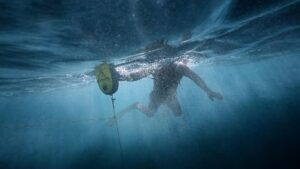Why use a float?
Spearfishing popularity throughout New Zealand seems to be skyrocketing each year, with no signs of slowing down. More and more kiwis are getting in the water looking to snag themselves a feed, or simply to enjoy the underwater environment. From personal experience, the longer I keep an interest in the sport, the smaller the dive bag seems to get… One piece of gear I am never without however, is a dive float.
Floats provide many extra aspects of safety and convenience when in the water, as well as being an essential piece of kit for landing big fish.

Whenever there is a diver in the water, boats are never too far behind. Many of our boating communities preach and practice responsible and safe driving, however a camouflaged diver is hard to spot even for the sharpest of eyes. Having a float out with a dive flag mounted on top is an easy way to ensure that they see you, and in turn that you stay safe. For those just starting out in the sport, something like this Beuchat double cell buoy will do the job perfectly, at a very reasonable price point as well.
Another reason for carrying a float is for convenient fish storage. Using a quick thread float line will not only allow you to spend less time securing your fish but enable the fish to float all the way to the end of your line while you continue looking for the next one. Bear in mind that a large number of fish on the front of any float will result in a lot of drag through the water, an alternative is to consider a fish threader than can be secured to the rear of the float for better streamlining.
Depending on your area and experience in the sport, you may find yourself running into fish that are far stronger than you are in the water, this is yet another scenario where a float can come in handy. By connecting your speargun to a float line, and by extension, your float, it ensures that any intended catch will have to fight against the buoyancy of the float, as well as whatever you have to give too. Just ensure you are only shooting fish you know your float can handle… otherwise you’ll quickly be back at your nearest dive shop for a new one!
Float types
The two most common dive floats across the market are the standard buoys, and the high-pressure floats. The reason to choose one over the other will usually depend on the terrain you are diving on, as well as the fish you intend to shoot, many spearos will own both for these different occasions.
A standard single atmosphere buoy like the Beuchat buoy above, as well as this Rob Allen torpedo style float are great for smaller targeted fish (think Butterfish, Blue Cod, Moki) as well as tighter spaces such as rocky areas where you may need to tow your float over the top of kelp beds. Often equipped with a quick inflation valve, they’re also perfect for slotting into a dive bag to store for the off season.
High pressure floats such as the range of mahi floats shown above are used in order to maximise the buoyancy of a float, whilst keeping the size to a reasonable scale too. The thick material combined with a sup style valve enables these floats to be able to be pumped to 2 atmospheres, this means a 10L float can have the equivalent buoyancy of a 20L float. These are most used for Bluewater excursions, or for some crossover reef shooting for larger Kingfish. A big plus I found with these floats is having great enough buoyancy to support a diver, making for an excellent safety tool should things get hairy.

Float uses
Most of the spearfishing done in NZ is out from shore, for these situations, the smaller, more versatile buoys are the most sort after pick, even some of the smaller high-pressure floats will do the job here. Having an extra few connection points on the float will allow you to attach a torch, cray bag/noose or even a water bottle.
The high-pressure floats are at home when tackling the bigger pelagic fish, being able to clip off multiple floats is also a big plus for the larger species. These floats have much greater drag, meaning you may not wish to tow it long distances, however this is ideal for wearing out anything on the other end. A dive flag is not always necessary for these floats, as most blue water locations are usually only reachable by boat, so keeping a flag visible on board makes the most sense.
The final way that floats can be used is as a beacon of sorts, with a drop weight. The most typical reason this system would be used is if the diver was opting for a reel setup on their speargun (if you’d like to know more about speargun reels, check out this article here). In essence, the buoy marks the general area the diver would be in, giving them the freedom to dive around the reef without the fear/annoyance of entanglement. It is important that if you are diving this style, that you move your buoy frequently to be close to the area you are diving.

The dive float is a bit of an ‘unsung hero’ of any spearos dive kit, and while there are a couple of factors that determine what sort of float will suit you best, the overall addition of safety and convenience is something that many would consider essential whenever they head out for the day.
For any of your spearfishing or diving needs, feel free to give us a call or come into store at Dive HQ.
